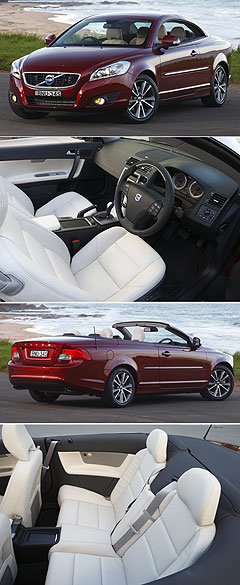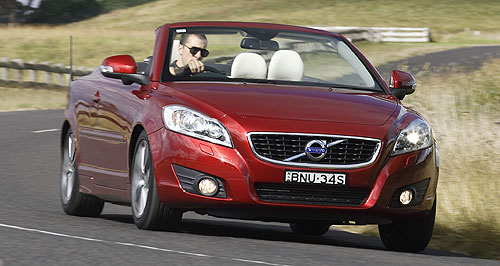Make / Model Search
New models - Volvo - C70 - Hardtop Convertible rangeFirst drive: Volvo softens hardtop convertibleTop-down revamp: Volvo's C70 gets a fresh nose as part of its mid-life makeover. Steady prices and a series of changes sum up the MY10 Volvo C704 May 2010 VOLVO’S C70 hardtop convertible has been given a similar mid-life makeover to its C30 three-door hatchback sibling, with no price rise despite the addition of a new safety feature. The main visual changes are reserved for the nose, while there is also a rear-end revamp and a cabin update. Bringing the front end in line with Volvo's new ‘V’ shape design language as shown in the coming second-generation S60 sedan, the C70 gets more angled headlights, a redesigned bumper, larger air intake and a more prominent Volvo badge set within a different grille. The LED tail-lights get a new shape, while the bumper has been restyled to better integrate the rear’s appearance.  The Swedes have also altered the dashboard with improved textures and materials, as well as new instrumentation that is specific to the MY10 C70. The Swedes have also altered the dashboard with improved textures and materials, as well as new instrumentation that is specific to the MY10 C70.The centre console features aluminium detailing with a new honeycomb surface while a grey/white Oyster Burst trim, which is inspired by the Swedish Hagström guitar as used by rock performers like Elvis Presley, is available. Volvo now uses softer leather on the seats, while a greater array of personalisation options have been devised. Mechanically the three-year-old four-seater drop-top remains pretty much the same, meaning that the 125kW230Nm 2.4-litre five-cylinder naturally aspirated petrol engine carries over in the opening S model, while the T5 turns up the heat courtesy of a 169kW/320Nm 2.5-litre five-pot turbo petrol unit. Both powerplants are available with a five-speed Geartronic automatic transmission with the choice of a sequential shift mode in lieu of the standard five-speed manual in the C70 S and a six-speed manual in the T5. If you prefer the former, expect a 220km/h top speed (auto: 215), a 0-100km/h-sprint time of about 9.1 seconds (auto: 10), an average economy figure of 9.0L/100km (auto: 9.6), and an emissions figure of 215g/km (auto: 229). Going with the turbo ups the ante – manual versus auto the numbers are 240km/h versus 235km/h, 7.6s versus 8.0s for the 0-100km/h dash, 9.1L/100km versus 9.8 for average fuel consumption and 217g/km versus 234 for CO2 emissions. As with other Volvos such as the latest C30 and XC60, a ‘Teknik Pack’ is available for a $6300 premium on the former and for $4725 on the latter. It features satellite navigation, the firm’s BLIS Blind Spot Identification System, adaptive headlights, a compass, Bluetooth connectivity and headlight washers. Among the standard features are a full suite of safety items including dual-stage front airbags, front side airbags and the pioneering door-mounted inflatable curtain airbags, as well as rear parking sensors, WHIPS anti-whiplash front seats, SIPS side impact protection system, the Roll-Over Protection System which, if necessary, deploys steel rollover bars behind the rear seats, safety belt pretensioners, stability and traction control and anti-lock brakes with Emergency Brake Assist. Finally, the MY10 C70 gains Volvo’s Emergency Brake Light system that flashes the brake lights five times a second in a forceful stop from more than 60km/h. When the vehicle’s speed dips below 10km/h, the hazard flashers take the place of the blinking tail-light items. Volvo says they can be manually deactivated or will disengage automatically once the speed exceeds 10km/h. Otherwise it’s business as usual for the hardtop convertible. To recap, it is a two-plus-two seater with what was a class-first three-piece folding roof design back in 2006. Designed in California, the C70 is built off the Ford Focus-derived C1 base underpinning the C30, S40, V50 and Mazda3. Among the benchmarks were the BMW E46 3 Series, Audi B6 A4 Cabriolet and Saab 9-3. The rack and pinion steering is powered by an electro-hydraulic system, brakes are discs all around, while the suspension is similar to S40/V50, so it’s a variation of the MacPherson strut front and independent multi-link Focus arrangement. With a considerable amount of body stiffening to stop flexing, the C70 is a hefty vehicle – tipping the scales from about 1700kg to more than 1725kg despite the use of weight-saving aluminium for the bonnet and boot lid. With the roof packed away, the boot offers just 130 litres, rising to 330 litres when the 30-second roof mechanism creates the ‘coupe’ aspect. Although the current C70 is a joint venture with Pininfarina, the Italian firm did not have a hand in the Volvo’s re-design. It is produced in Uddevalla, Sweden.
 Quick testsRead moreAll new models Alfa Romeo Alfa Romeo Abarth Abarth Alpine Alpine Alpina Alpina Audi Audi Aston Martin Aston Martin BMW BMW Bentley Bentley Chery Chery Brabham Brabham Chrysler Chrysler Chevrolet Chevrolet Cupra Cupra Citroen Citroen DS DS Dodge Dodge Fiat Fiat Ferrari Ferrari Foton Foton Ford Ford Great Wall Great Wall FPV FPV Haval Haval GWM GWM Honda Honda Holden Holden Hyundai Hyundai HSV HSV Isuzu Isuzu Infiniti Infiniti Jeep Jeep Jaguar Jaguar Lamborghini Lamborghini Kia Kia LDV LDV Land Rover Land Rover Lotus Lotus Lexus Lexus Maserati Maserati Mahindra Mahindra McLaren McLaren Mazda Mazda Mercedes-Benz Mercedes-Benz Mercedes-AMG Mercedes-AMG Mini Mini MG MG Nissan Nissan Mitsubishi Mitsubishi Pagani Pagani Opel Opel Porsche Porsche Peugeot Peugeot Ram Ram Proton Proton Rolls-Royce Rolls-Royce Renault Renault Saab Saab Rover Rover Smart Smart Skoda Skoda Subaru Subaru SsangYong SsangYong Tesla Tesla Suzuki Suzuki Toyota Toyota Volvo VolvoMotor industry news |
|
||||||||||












Facebook Twitter Instagram